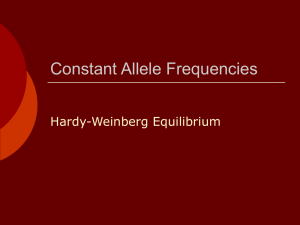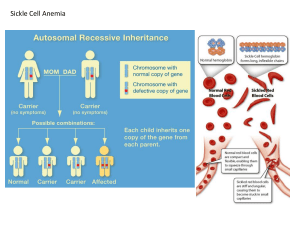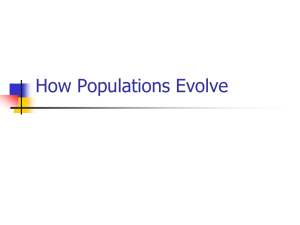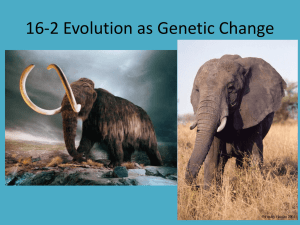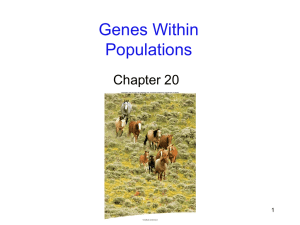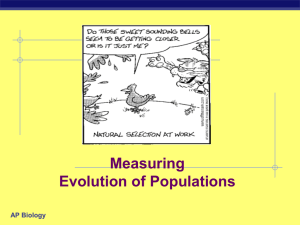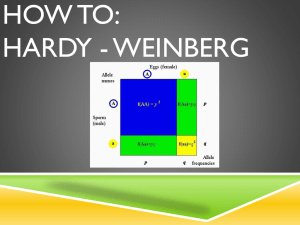Calculation of Allele and Genotype Frequencies & Hardy
advertisement
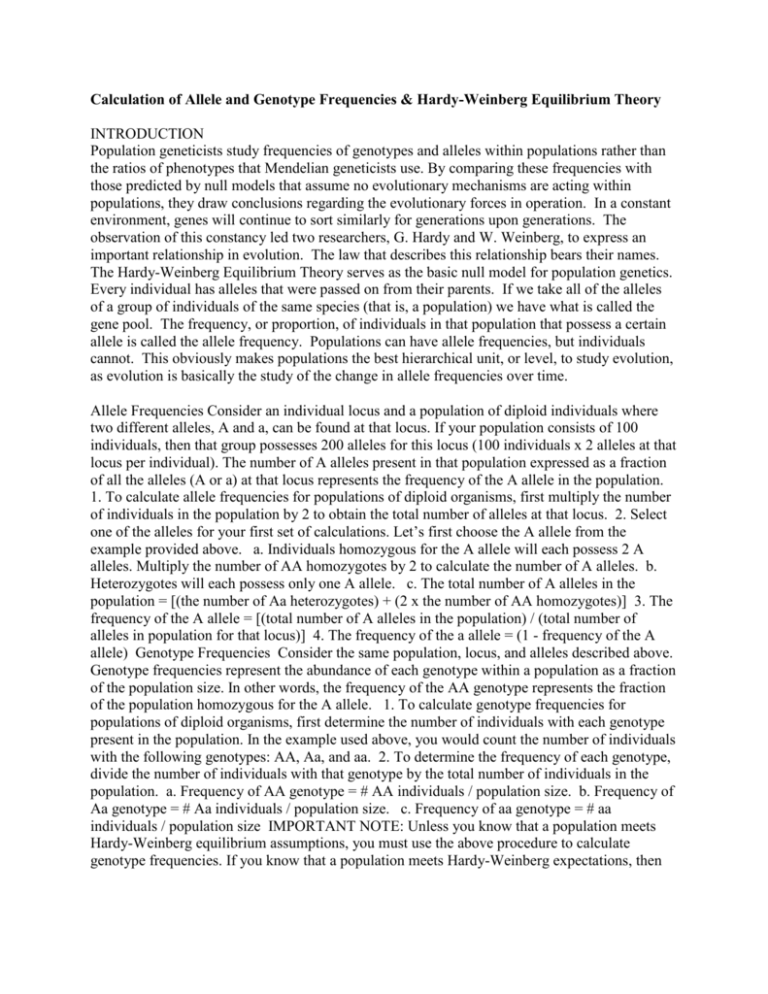
Calculation of Allele and Genotype Frequencies & Hardy-Weinberg Equilibrium Theory INTRODUCTION Population geneticists study frequencies of genotypes and alleles within populations rather than the ratios of phenotypes that Mendelian geneticists use. By comparing these frequencies with those predicted by null models that assume no evolutionary mechanisms are acting within populations, they draw conclusions regarding the evolutionary forces in operation. In a constant environment, genes will continue to sort similarly for generations upon generations. The observation of this constancy led two researchers, G. Hardy and W. Weinberg, to express an important relationship in evolution. The law that describes this relationship bears their names. The Hardy-Weinberg Equilibrium Theory serves as the basic null model for population genetics. Every individual has alleles that were passed on from their parents. If we take all of the alleles of a group of individuals of the same species (that is, a population) we have what is called the gene pool. The frequency, or proportion, of individuals in that population that possess a certain allele is called the allele frequency. Populations can have allele frequencies, but individuals cannot. This obviously makes populations the best hierarchical unit, or level, to study evolution, as evolution is basically the study of the change in allele frequencies over time. Allele Frequencies Consider an individual locus and a population of diploid individuals where two different alleles, A and a, can be found at that locus. If your population consists of 100 individuals, then that group possesses 200 alleles for this locus (100 individuals x 2 alleles at that locus per individual). The number of A alleles present in that population expressed as a fraction of all the alleles (A or a) at that locus represents the frequency of the A allele in the population. 1. To calculate allele frequencies for populations of diploid organisms, first multiply the number of individuals in the population by 2 to obtain the total number of alleles at that locus. 2. Select one of the alleles for your first set of calculations. Let’s first choose the A allele from the example provided above. a. Individuals homozygous for the A allele will each possess 2 A alleles. Multiply the number of AA homozygotes by 2 to calculate the number of A alleles. b. Heterozygotes will each possess only one A allele. c. The total number of A alleles in the population = [(the number of Aa heterozygotes) + (2 x the number of AA homozygotes)] 3. The frequency of the A allele = [(total number of A alleles in the population) / (total number of alleles in population for that locus)] 4. The frequency of the a allele = (1 - frequency of the A allele) Genotype Frequencies Consider the same population, locus, and alleles described above. Genotype frequencies represent the abundance of each genotype within a population as a fraction of the population size. In other words, the frequency of the AA genotype represents the fraction of the population homozygous for the A allele. 1. To calculate genotype frequencies for populations of diploid organisms, first determine the number of individuals with each genotype present in the population. In the example used above, you would count the number of individuals with the following genotypes: AA, Aa, and aa. 2. To determine the frequency of each genotype, divide the number of individuals with that genotype by the total number of individuals in the population. a. Frequency of AA genotype = # AA individuals / population size. b. Frequency of Aa genotype = # Aa individuals / population size. c. Frequency of aa genotype = # aa individuals / population size IMPORTANT NOTE: Unless you know that a population meets Hardy-Weinberg equilibrium assumptions, you must use the above procedure to calculate genotype frequencies. If you know that a population meets Hardy-Weinberg expectations, then you can calculate genotype frequencies using allele frequencies and the Hardy-Weinberg equations (see below). Assertions of the Hardy-Weinberg Equilibrium Theory The Hardy-Weinberg Equilibrium Theory refers to loci within populations that experience no evolutionary mechanisms (i.e., selective forces). For such populations the theory asserts that: 1. Allele and genotype frequencies should remain constant from one generation to the next. That is, no evolution should occur at these loci. If, at a certain gene locus, there are only two alleles each will have a frequency such that the frequency of one allele plus the other equals one. Remember, we are discussing the frequency in a population, not in an individual. Formally, we can state the allelic frequency in a population as follows: p = Frequency of allele A = freq(A) q = Frequency of allele a = freq(a) and p + q = 1 2. Given a certain set of allele frequencies, genotype frequencies should conform to those calculated using basic probability. In a one locus/two allele system such as the one described above, the genotype frequencies should be as follows: a. Frequency of AA genotype = (frequency of A allele)2 b. Frequency of aa genotype = (frequency of a allele)2 c. Frequency of Aa genotype = 2 x (frequency of A allele) x (frequency of a allele) Within a population, the frequency of the possible combinations of a pair of alleles at one locus is related to the expansion of the binomial (p + q)2. Remember that if we square one side of the equation we must square the other side, such that (p + q)2 = 12. The expansion is (p + q) x (p + q) = p2 + 2pq + q2 = 1, where p2 = Frequency of genotype A/A 2pq = Frequency of genotype A/a q2 = Frequency of genotype a/a 3. If the genotype frequencies obtained from a real population do not agree with those predicted by the Hardy-Weinberg Theory, then population geneticists know that some evolutionary mechanism or mechanisms must operate on the locus of interest. Knowledge of the theory can help narrow down the possible mechanisms. Then they can use experiments to determine which potential mechanism or mechanisms operate on the locus. As such, the HardyWeinberg Equilibrium Theory serves as an important tool for population geneticists. Assumptions of the Hardy-Weinberg Equilibrium Theory (Evolutionary Mechanisms) Populations will conform to the Hardy-Weinberg Theory assertions only if no evolutionary forces or mechanisms influence the loci under consideration. The assumptions that populations must meet in order for the Hardy Weinberg assertions to hold include: 1. Large population size (i.e., no genetic drift). Random chance can alter allele frequencies through mating processes and death within small populations. 2. Random mating, which means that the choice of mates by individuals in the population is determined by chance, and not influenced by the genotypes of the individuals in question. 3. No difference in the mutation rates between alleles at the same locus. 4. Reproductive isolation from other populations (i.e., no gene flow or migration). 5. No differential survival or reproduction among phenotypes (i.e., no natural selection). Example Consider a population of 1000 individuals and the locus and alleles described above. Assume that you have no information on the presence or absence of evolutionary mechanism in this population. You find that the population consists of: 90 individuals homozygous for the A allele (AA genotype) 490 individuals homozygous for the a allele (aa genotype) 420 heterozygotes (Aa genotype) 1. Calculate the genotype and allele frequencies for this locus. 2. Determine if this population meets Hardy Weinberg Assumptions (in other words determine if evolutionary mechanisms operate in this population). Calculation of Allele and Genotype Frequencies Since you do not know if this population meets Hardy Weinberg Assumptions, you must calculate both the allele and genotype frequencies using the raw data. 1. Allele Frequencies: The frequency of the A allele will equal: (total number of A alleles in the population) / (total number of alleles in population for locus) = [(90*2) + 420] / (1000*2) = 0.30 The frequency of the a allele will equal: (1 - 0.30) or (total number of a alleles in the population) / (total number of alleles in population) = [(490*2) + 420] / (1000*2) = 0.70 2. Genotype frequencies: Frequency of AA genotype = # AA individuals / population size = 90/1000 = 0.09 Frequency of Aa genotype = # Aa individuals / population size = 420/1000 = 0.42 Frequency of aa genotype = # aa individuals / population size = 490/1000 = 0.49 Hardy-Weinberg Predictions If no evolutionary mechanisms operate on this locus, then the Hardy-Weinberg Equilibrium Theory predicts that the genotype frequencies should be as follows: Frequency of AA = (frequency of A allele)2 = (0.3)2 = 0.09 Frequency of Aa = 2 x (frequency of A allele) x (frequency of a allele) = 2*0.3*0.7 = 0.42 Frequency of aa = (frequency of a allele)2 = (0.7)2 = 0.49 Conclusion Since the observed genotype frequencies equal those predicted by the Hardy-Weinberg Equilibrium Theory, we conclude that no evolutionary mechanisms operate on this locus in this population (i.e., the population meets the assumptions of the Hardy Weinberg Theory). ACKNOWLEDGEMENTS The mating portion was adapted from one used in the General Biology Program at Duke University and Pennsylvania State University; its origin is attributed to Dr. Paulette Peckol (Smith College). The synopsis of Hardy-Weinberg Equilibrium Theory was written by Dr. Patricia Peroni and the Populus Instructions were written by Drs. Mark Stanback and Chris Paradise.
